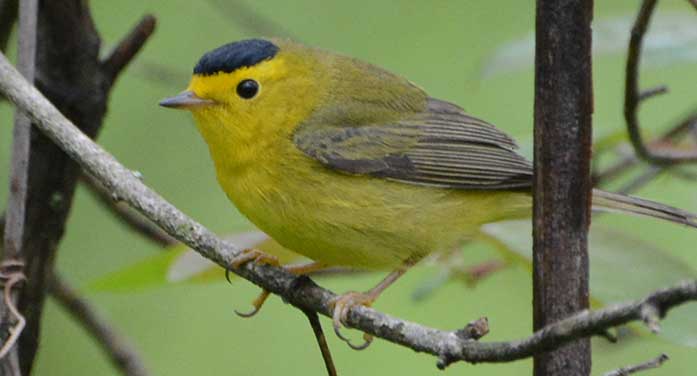
Wilson’s Warbler
 Spring is an exciting time of year as everything awakens and regrowth is rampant.
Spring is an exciting time of year as everything awakens and regrowth is rampant.
I always eagerly anticipate the return of the birds that migrated southbound last fall. Their beauty and – more importantly – their song delights and revitalizes me.
I know where they go, but I seldom get a chance to see them on their wintering grounds.
My wife and I just returned from our first trip in over two years and we visited our villa in Honduras. This lovely oasis is right beside Pico Bonito National Park, a birder’s paradise.
Daily tropical delights greeted us as we took long walks along the trails that criss-cross the property – toucans, parrots, hummingbirds, butterflies, lizards, gorgeous flowering trees and shrubs, and towering mountains were our constant companions.
I saw many species in Honduras that I would expect or hope to see during our Ontario summers and was enthralled that these tiny sprites were soon going to fly thousands of kilometres back to Canada.
Vireos were present in abundance and included our familiar red-eyed, white-eyed Philadelphia, warbling and yellow-throated. The latter is by far the most common, but the irony is that the yellow-throated is a very uncommon species in most of Ontario, so its abundance was puzzling. Where do they go?
While none of our woodpeckers or finches and only a few of our hawks get to Honduras, most of our warblers do. They either overwinter there or pass through on their way even farther south.

Magnolia Warbler
I recorded many species of warblers, including several that are difficult to find anywhere in Canada – prothonotary, Kentucky, yellow-throated, hooded and worm-eating warblers, as well as Louisiana waterthrush and yellow-breasted chat.
In addition, many common species that nest in or migrate to Canada were present in abundance, including black-throated green, black-and-white, yellow, Tennessee and palm warblers.
Other delightful and regular summer birds included our tiny hummingbird, the ruby-throated, which shared flowers with hummingbird species we will never see in Eastern Canada, such as emeralds, jacobins, hermits, barbthroats and woodnymphs. The grey catbird and wood thrush were abundant – I can’t wait to hear the beautiful flute-like song of the latter in a few weeks in my yard.
I thought I might see more of our flycatchers, but only the eastern wood-pewee and great-crested and yellow-bellied flycatchers put in an appearance – but a welcome one at that!

A glimpse of the Honduran landscape
One of the cheeriest songs we encountered came from one of the drabbest birds – the diminutive house wren, which belts out its song day after day once it returns to Canada in early May. Each morning in Honduras, they serenaded us at dawn.
This was an interesting observation as none of the other migrant species sang even a whisper of their songs. The warblers and vireos that sing beautifully when in Ontario were silent and only made occasional irritated chipping sounds when the mood fit. Their migration will be exhausting so I guess there’s no sense singing up a storm and wasting energy during migration. There will be time for that soon enough.
Many of the birds were moulting and clearly stressed as their soon-to-be-beautiful plumages develop just before they leave Honduras. Others will finish the moult during migration.
It was intriguing to look at the plumages in detail – the Tennessee warbler was perhaps the most common species I saw. Its plumage ranged from a beautiful adult male to a drab, almost unrecognizable, immature plumage that no bird would be proud to wear.

Yellow Warbler
Many others, such as the hooded warbler, were in their full glory, but perhaps the best show was put on by the Baltimore orioles – dressed to the nines, their flaming orange feathers virtually glowed in the tropical sun.
So now I wait for them to return to Canada. It will be nice to see them again after having shared two countries with some of them.
Geoff Carpentier is a published author, expedition guide and environmental consultant. Visit Geoff on LinkedIn, Instagram and Facebook. For interview requests, click here.
The opinions expressed by our columnists and contributors are theirs alone and do not inherently or expressly reflect the views of our publication.
© Troy Media
Troy Media is an editorial content provider to media outlets and its own hosted community news outlets across Canada.

